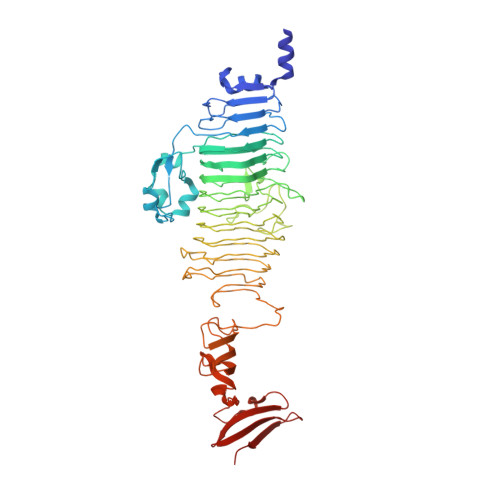Structure of the Receptor-Binding Protein of Bacteriophage Det7: A Podoviral Tail Spike in a Myovirus.
Walter, M., Fiedler, C., Grassl, R., Biebl, M., Rachel, R., Hermo-Parrado, X.L., Llamas-Saiz, A.L., Seckler, R., Miller, S., van Raaij, M.J.(2008) J Virol 82: 2265-2273
- PubMed: 18077713
- DOI: https://doi.org/10.1128/JVI.01641-07
- Primary Citation of Related Structures:
2V5I - PubMed Abstract:
A new Salmonella enterica phage, Det7, was isolated from sewage and shown by electron microscopy to belong to the Myoviridae morphogroup of bacteriophages. Det7 contains a 75-kDa protein with 50% overall sequence identity to the tail spike endorhamnosidase of podovirus P22. Adsorption of myoviruses to their bacterial hosts is normally mediated by long and short tail fibers attached to a contractile tail, whereas podoviruses do not contain fibers but attach to host cells through stubby tail spikes attached to a very short, noncontractile tail. The amino-terminal 150 residues of the Det7 protein lack homology to the P22 tail spike and are probably responsible for binding to the base plate of the myoviral tail. Det7 tail spike lacking this putative particle-binding domain was purified from Escherichia coli, and well-diffracting crystals of the protein were obtained. The structure, determined by molecular replacement and refined at a 1.6-A resolution, is very similar to that of bacteriophage P22 tail spike. Fluorescence titrations with an octasaccharide suggest Det7 tail spike to bind its receptor lipopolysaccharide somewhat less tightly than the P22 tail spike. The Det7 tail spike is even more resistant to thermal unfolding than the already exceptionally stable homologue from P22. Folding and assembly of both trimeric proteins are equally temperature sensitive and equally slow. Despite the close structural, biochemical, and sequence similarities between both proteins, the Det7 tail spike lacks both carboxy-terminal cysteines previously proposed to form a transient disulfide during P22 tail spike assembly. Our data suggest receptor-binding module exchange between podoviruses and myoviruses in the course of bacteriophage evolution.
Organizational Affiliation:
Physical Biochemistry, University of Potsdam, Karl-Liebknecht-Str. 24-25, Haus 25, D-14476 Potsdam-Golm, Germany.















